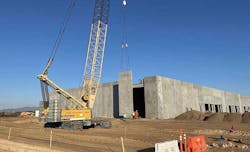Executive Insights: Nancy Novak, Compass & Infrastructure Masons
The Data Center Frontier Executive Roundtable features insights from industry executives with lengthy experience in the data center industry. Here’s a look at the insights from Nancy Novak of Compass Datacenters and Infrastructure Masons.
NANCY NOVAK, Compass Datacenters and iMasons
Nancy Novak, Compass Datacenters’ Chief Innovation Officer, has over 25 years of construction experience and has overseen the delivery of over $3.5 billion in projects during that time. Prior to joining Compass, Nancy was the National Vice President of Operations for Balfour Beatty Construction which she joined after serving in a variety of executive positions for Hensel Phelps Construction Company. Novak is a member of the iMason’s advisory council and is actively involved in a number of organizations dedicated to the advancement of woman in business including Above the Glass Ceiling (AGC) who are working with Fortune 500 companies to aid in the advancement of women in STEM, Women in Government Relations (WGE), Women Construction Owners and Executives (WCOE), The World Trade Center Initiative, Fortune Media’s Most Powerful Women and the National Women’s Party. Nancy is a frequent speaker on the topic and has participated in the White House Womens and Diversity in STEM forums. Nancy holds a degree in Construction Engineering and Management from San Diego State University.
Here’s the full text of Nancy Novak’s insights from our Executive Roundtable:
Data Center Frontier: Data center staffing was already a challenge as we entered 2020. What is the impact of the COVID-19 crisis on data center staffing and operations, both in the short-term and long-term?
Nancy Novak: I think COVID has impacted data center operations in a few ways. First, I think that it’s illustrated that for all of the automated and software-based capabilities that support data centers, the essential element for ensuring their ubiquitous level of availability is still the people who physically operate the facility. That’s a good thing, because I believe that sometimes we try to implement technological solutions to solve problems or perform tasks that are better conducted by technicians providing hands on-support.
The crisis has definitely forced the industry to re-evaluate operational processes and procedures that have probably reached the counter-productive “we’ve always done it this way” threshold. For example, can shift changes be conducted indirectly or maintenance schedules modified in terms of their frequency or timing without negatively impacting facility performance? While no one likes having a pandemic be a catalyst for re-examining the way we do business, it has shown us how easy it for complacency to diminish our focus on continually improving our operations.
As to the future, I think it would be fair to say that COVID illuminated our lack of depth in terms of personnel with skill sets to support our facilities; a situation that will be exacerbated due to the obvious accelerating need for data center capacity in the coming years. From a positive perspective, we emerge post-pandemic with a clearer understanding of how necessary it is for the industry to become more actively involved in promoting efforts in areas such as encouraging more woman and minorities to pursue STEM-related careers to both diversify, but more importantly, broaden the base of talent to draw from to meet growing demand.
“While no one likes having a pandemic be a catalyst for re-examining the way we do business, it has shown us how easy it for complacency to diminish our focus on continually improving our operations.”
Nancy Novak, Compass Datacenters & Infrastructure Masons
Data Center Frontier: How are enterprises sorting out their data center and cloud options in the shadow of the pandemic? What are the key questions and issues you are hearing in conversations with enterprise customers?
Nancy Novak: Certainly, we are seeing a heightened level of concern directed towards operations and that makes sense. If I’m a company like ZOOM, for example, and I know my volume of users is only going to increase I want to be sure that the people who operate the data centers I’m housed in can ensure uninterrupted operation. The bigger “issue”, and I mean that in a good way, that we’re already seeing is customers and prospects wanting to know more about our plans for campus development and our speed of delivering capacity. The social, economic and work-related changes arising in a post-COVID world have made it obvious to any cloud or SaaS provider that they are going to need a lot more capacity and require it’s delivery much faster than they may have previously expected.
A pre-fabricated concrete section being hoisted into place during the construction of a Compass Datacenters campus. (Photo: Compass Datacenters)
Data Center Frontier: The workforce is suddenly more distributed than ever. What’s your take on the current trajectory of edge computing? Has it been changed in any way by the pandemic?
Nancy Novak: Conceptually I think that we’ll see companies realizing customer satisfaction and application performance is going to require moving compute and storage closer to end users, but with one man’s edge being another’s conveniently located colo facility, it’s going to be very difficult to quantify the growth in “edge computing.”
Despite the hype, you could argue that the optimal model for providing localized data center functionality is still unclear. Who are the real players going to be and how will these capabilities be deployed and productized is still an open question, and how much of the “marketplace” will be made up of enterprises, cloud providers, et. al. implementing their own extended networks remains to be seen.
The post-pandemic world will certainly prod a number of companies that have been taking a wait and see approach to begin looking how edge computing fits into their overall strategy, but it’s going to take a few years to sort things out to the point that we can actually say what, if any, impact COVID had on market momentum.
Data Center Frontier: Power and cooling equipment are the heart of any data center. What’s the prognosis for the data center supply chain and the logistics of deploying new data center capacity?
Nancy Novak: Maintaining a level of development and construction to keep supply level with demand is only going to be an increasing challenge. Right now, being able to deliver a facility in six months is becoming more of a standard requirement, and I’m not sure how much more time can be shaved from that timeframe.
The new challenge will be to be to maintain that level of velocity across multiple locations here in the U.S. and internationally. In order to compete in this new landscape, it is going to require providers to tighten their supply chains to ensure that critical components, particularly long lead parts, and materials are available in synch with schedule require of course.
However, the most important areas for providers to ensure that they are successfully leveraging technology (BIMs, VR/AR, etc.) in both the design and construction phases of their efforts. Capabilities like VR, for example, identify potential problems before they are discovered on the job site to help ensure schedule integrity. Technology will also be important in helping to provide the number of personnel required to support multiple projects. Advances in exoskeleton functionality is just one area that enables women to become more active participants on the jobsite, thereby helping to address the needs for an expanded labor pool.

